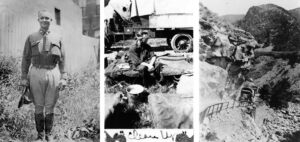Have you ever wondered who invented the mud flap? It’s really quite an ingenious solution to a common problem.
When I was a tot — no longer an infant but not quite a toddler — my older brother, Phil, and a family friend found a can of white spray paint in the garage of our home in southern Maine.
With red hair and the pale skin that most “gingers” are cursed with, I was already about as white as any youngster on the planet could be. Even so, Phil and his 4-year-old comrade decided I still had a bit too much tint. In short order, family lore says, the offenders sprayed me white from head to toe. I must have been smart enough to shut my eyes, because I’ve been told that’s all that distinguished me from a snowbank.
Dad must have had experience with this sort of thing. He cleaned me up using a couple of cups of gasoline. I suppose in the 21st century, his cleaning solution would be ill-advised. But, keeping in mind that the U.S. was spraying Agent Orange on our soldiers in Vietnam at the time and the average farmer used enough DDT on a crop to kill medium-sized mammals, I suppose gasoline was considered a “mild” detergent.
Fast forward about three years. Phil now rode a bicycle, sans training wheels. It was a sparkling green Huffy model, complete with a banana seat and a “sissy bar.” We called it the “green banana.” Whereas most bikes today sport tires less than an inch wide, the rims on the green banana accommodated 2, maybe 2 1/2-inch tires, for added stability, I suppose.
In any case, those tires could pick up and sling some serious mud. But mud wasn’t Phil’s nemesis. He came high-tailing down the hill toward our house one afternoon, ignoring the “road closed” signs and oblivious to the fact the town had just sprayed a heavy liquid asphalt sealant on the road (we just called it “tar”).
Well, as you can imagine, those wide bike tires tossed tar into the air like a whale clearing its spout. Phil’s bike left an indelible mark on the road that afternoon, and he arrived home covered with sticky, gooey black substance covering his bike and most of his body.
Once again, Dad got the gasoline – probably about 5 gallons of it this time – and gave my brother a “bath.” I’ve been told Phil’s scrubbing was much more vigorous than mine after the spray-painting incident, and Dad may have even drawn blood. The green banana was forever altered, and my brother shed flakes of black tar for days. I called it karma.
So, what does all this have to do with mud flaps?
Well, while my spray painting was a nefarious plot, Phil couldn’t be completely blamed for the tar incident. After all, the Huffy bicycle company did not consider installing the one accessory that might have protected him from being coated in tar that afternoon — mud flaps.
Recently, reminiscing about these two episodes, I got to thinking. When did the trucking industry start installing mud flaps on trucks and trailers? Who came up with this simple yet ingenious idea? The history of mud flaps must be obscure, I thought. So, I turned to the internet to see what I could find. In a matter of seconds, I had my answer.
Some time ago, the Fruehauf Trailer Historical Society commissioned Darlene Norman to research the tale of the mud flap. After running down several paths, she finally concluded her investigation.
During World War II, Oscar Glenn March Sr., a native of Oklahoma, was an inventor. According to Norman, March seldom bothered to patent any of his ideas. Perhaps the most famous of those was the mud flap.
March spent a 40-year career in the military as a motor pool driver in the Army and Air Force. By the time he retired in 1983, he had accrued 2 million event-free miles, an accomplishment credited to his driving skills. That’s an impressive number, considering the various vehicles and cargo a military driver must operate and carry over the years.
It seems March invented the mud flap while stationed at Tinker Air Force Base in Oklahoma.
According to Norman, in a 1983 interview with Ellie Posey, March said he “made the flaps because the main drive wheels of big rigs kicked up rocks, mud, water and debris that damaged the delicate cargo. Much of the radar equipment he and other drivers delivered was sensitive to moisture, and rock damage was common.”
The author continued, “To solve the problem, March designed tarps to trap the water and rocks. His mud flap was modified, and soon every tractor rig operating at Tinker was equipped with them. Not only did this invention prevent damage to the cargo, but it also prevented damage or injury to following vehicles and their occupants. The law now requires the use of mud flaps on big rigs.”
Today, March is generally credited as the inventor of the mud flap.
His 1994 obituary read, “Oscar, being very modest, rarely tells anyone he is a famed inventor — inventing the mud flaps that are now required on all big rigs. He also came up with the bracket and canvas system that is attached to flat-bed trucks to prevent damage to equipment. This system is still used by the military during long-haul deliveries. While working at Tinker, he came up with many more inventions that are still currently used on the base.”
Of course, what started as a canvas flap has been improved over the decades. Rubber and composite materials have replaced the original canvas, and the flaps have been engineered to reduce drag and minimize interference with operation of a big rig.
They have also taken on roles other than just limiting flying rocks and mud. Many motor carriers use mud flaps for advertising. About 30 years ago, someone came up with the idea of customizing mud flaps to suit the tastes of the driver. Who can forget “Mudflap Girl” — the chrome silhouette of a shapely woman that has adorned countless mud flaps since the 1970s? (“Mudflap Girl” has a history, but we won’t go into that here.)
Chrome silhouettes became quite popular based on the prominence of “Mud Flap Girl.” Other drivers attached similar pieces of art, ranging from images to trucks and boats to other motifs, to mud flaps; a few even attached messages. Since then, the industry of customized mud flaps has exploded. You can get just about any design you’d like stamped in color into mud flaps — provided, of course, it meets the requirements of the National Transportation Safety Board. Likely, those requirements are included in page upon page of federal government legal language, but I haven’t bothered to research that issue yet.
Take notice of mud flaps the next time you’re on the highway, and give a nod to Oscar Glenn March Sr. when you do. You’ll find an array of messages on such an innocuous object. And there’s one thing you can’t help but notice: “Mudflap Girl” hasn’t aged a bit.
Since retiring from a career as an outdoor recreation professional from the State of Arkansas, Kris Rutherford has worked as a freelance writer and, with his wife, owns and publishes a small Northeast Texas newspaper, The Roxton Progress. Kris has worked as a ghostwriter and editor and has authored seven books of his own. He became interested in the trucking industry as a child in the 1970s when his family traveled the interstates twice a year between their home in Maine and their native Texas. He has been a classic country music enthusiast since the age of nine when he developed a special interest in trucking songs.















